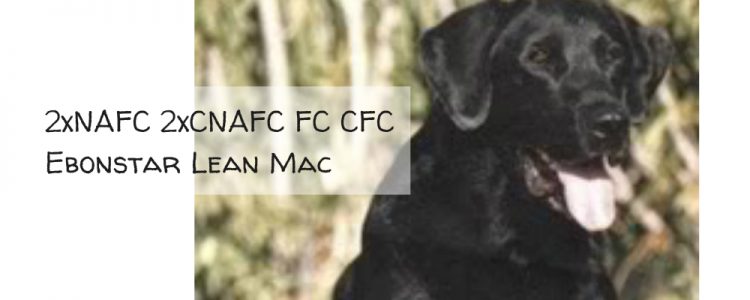
Out of curiosity, I looked into the pedigree of 2xNAFC 2xCNAFC FC CFC Ebonstar Lean Mac who was probably the most influential field Labrador Retriever in recent history.
Why was he so influential?
He earned a Field Championship (FC) and an Amateur Field Championship (AFC) in BOTH the US and Canada.
He also won the National Amateur Field Championship (NAFC) twice and he won the Canadian National Amateur Field Championship (CNAFC) twice. (Learn more about title abbreviations.)
And he produced many dogs who earned hunt test titles, field championships and won more national championships.
But today we’re going to look at some of his ancestors. So who does he descend from?
Here’s his 3-generation pedigree:
| CNFC CNAFC Waldorf’s High Tech | CFC Rascal’s Super Spud | NAFC FC Ray’s Rascal |
| Sirion’s Super Snooper | ||
| Itch’s Flying Tiger | FC AFC Itchin’ To Go | |
| Thor’s Tiger Lillie | ||
| Ebonaceae Princess WCX QAA | Trieven El Conquistador | FC AFC CFC Trieven Thunderhead |
| Trieven High Speed | ||
| Skookum’s Sky Raider | CFC CAFC Virdon’s Tuktoyaktuk | |
| Wilkie’s Cinderella Liberty |
It’s when you go back further that you find ancestors some people might find surprising –
3xNFC CFC DUAL CH Shed of Arden (19)
DUAL CH Matchmaker for Deer Creek (4) – and his sire and grandsire:
DUAL CH CFC Little Pierre of Deer Creek (15)
Am Eng CH Banchory Trump of Wingan (4)
DUAL CH Cherokee Buck (6) – and his sire:
DUAL CH Grangemead Precocious (12)
Can DUAL CH Coastal Charger of Deer Creek (16) (another son of Little Pierre)
NFC DUAL CH CFC Bracken Sweep (8)
CH Whygin Poppitt (3)
Can DUAL CH Dart of Netley Creek (3)
FTCH CAN DUAL CH Treveilyr Swift (1)
Eng Can CH Sandylands Jilly (1)
DUAL CH CFC Ridgewood Playboy (1)
DUAL CH AFC Hello Joe of Rocheltree (1)
CNFC CAN DUAL CH AFC Stormy Of Spirit Lake Gal (1)
ENG DUAL CH Staindrop Saighdear (1)
CAN DUAL CH CAFC Netley Creek’s Black Drake (1)
(The numbers following the names are the number of times that dog shows up in his 10 generation pedigree.)
Maxx is very well known in the field trial and hunt test communities, but many people don’t realize how many SHOW DOGS are in his pedigree.
To be fair, many of these dogs lived during a time when Labs competed in both field trials and dog shows and could earn championships in both. There hasn’t been a DUAL CHAMPION Labrador since the 1980s though.
There are also numerous FC, AFC, NFC and NAFC dogs, such as NFC 2xNAFC Super Chief, NAFC FC CFC Guy’s Bitterroot Lucky, NFC AFC Massie’s Sassy Boots, Eng IGL CH FTCH Glenhead Zuider, NFC AFC CFC Cork of Oakwood Lane, NAFC FC Ray’s Rascal, NFC AFC Marvadel Black Gum.
I had two of Maxx’s granddaughters, including Clubmead’s Dark Crystal, and many of my current dogs descend from her. While her pedigree has several American and Canadian FC and AFCs, plus a healthy dose of National Field Champions, if you follow her maternal line you’ll find some show dogs in her pedigree too. One top dog – AM CAN CH Shamrock Acres Light Brigade – shows up three times. By the way, CH Whygin Poppitt, who shows up in Maxx’s pedigree, is also the grandsire of Light Brigade.
It wasn’t that long ago Labradors came from one gene pool. There weren’t “American” Labs or “English” Labs, they were all just Labrador Retrievers.
Does that make you stop and think about recent breeding choices?
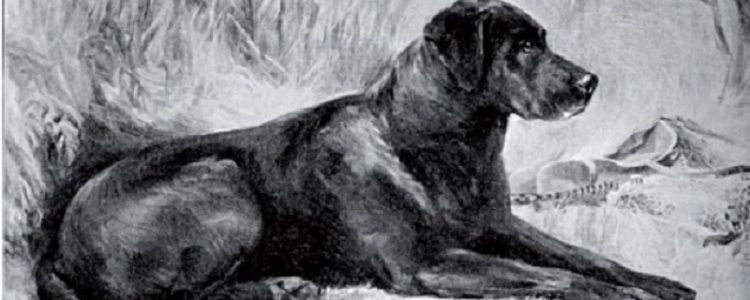
British field trials
The first documented field trial was held in England in 1899 and consisted mostly of Flat-Coated and Curly Coated retrievers.
Four years later Munden Single became the first Labrador to win a Challenge Certificate (like ‘winning the points’ in an AKC dog show).
Then the following year she became the first Labrador to run in a field trial.
Dual purpose Labradors have been around for a long time!
“It is improbable that Labradors will be as popular as the Flat-coated Retrievers; they are essentially a working breed and do not lend themselves to popularity. However, if one can take the numbers registered at the Kennel Club as some sort of a guide, the breed is becoming more widely known and appreciated, but it is hoped that they will never be kept for the purpose of showing only.”
The Labrador Retriever – A complete Anthology of the Dog
Quoting Maurice Portal, circa 1912
Courtesy: Google Books
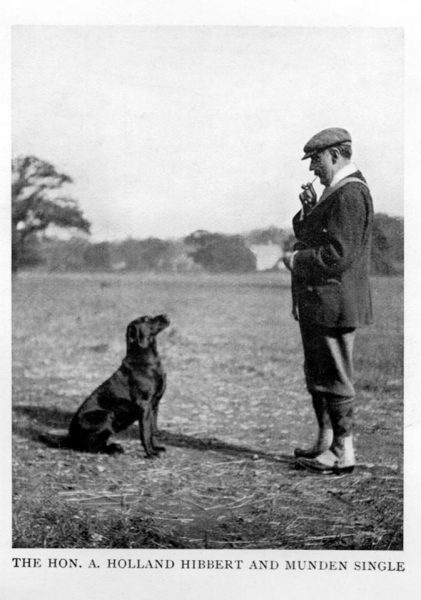
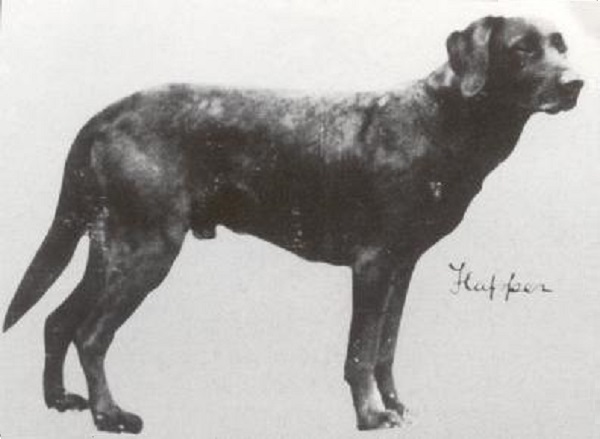
MAURICE PORTAL AND FTCH FLAPPER
A few years later, three Labradors ran in another field trail against a field of mostly Flat-Coated retrievers. All three Labs were related.
Munden Single had three Buccleuch grandparents and the fourth descended from Buccleuch dogs.
Flapper’s pedigree included Buccleuch Avon, Buccleuch Ned, Malmesbury’s Tramp, Malmesbury’s Juno – dogs that also appear in Munden Single’s pedigree.
The third Lab was Dungavel Juno, a granddaughter of Munden Sentry who was a full brother to Munden Single.
Note: Flapper is also shown laying down at the top of the page.
More on this early field trial:
“The next item of importance that took place in 1907, was the 2nd All-Aged Stake held by the [English] Kennel Club on November 26th & 27th.
“In a field of 20 runners there were fifteen Flat Coats, three Labradors, and two others.
“The Labradors were Mr. Portal’s Flapper, The Duchess of Hamilton’s Dungavel Juno, and Holland-Hibbert’s Munden Single.
“So foul was the weather on the morning of the first day that a vote was taken of handlers and guns whether to continue after lunch – a situation known to many hardened field triallers. Fortunately, they voted to continue, which gave an historic result.
“Flapper was first, Juno was second and M. Single gained the fourth prize. The Labrador had arrived on the field trial scene with a vengeance.
“Flapper, who became a FT Champion, was handled by Maurice Portal, a man who, as Vice Chairman, was to play a major role in the direction of the Labrador Club in its formative years.
“This was the first time a Labrador had won a major stake. Flapper was 5 years old when he won this trial and was to continue to win further honours. He was to become a powerful stud force siring many litters.
“It was Flapper more than any dog to date, whose brilliant accomplishments made an enormous impression on the shooting public. More than any other dog he convinced the public of the superiority of the Labrador over the previously ubiquitous Flat Coats.”
Field Trials – Past Achievements (Part I to 1914) – George Jenken on
http://www.thelabradorretrieverclub.com/news-articles

FTCH PETER OF FASKALLY
In 1911, FTCH Peter of Faskally won the International Gundog League’s Championship Stake for retrievers. His handler, Archibold Butter, adapted whistle and hand signals from working sheepdogs to guide Peter to unseen birds. This was the beginning of ‘handling’ that we see today in field trials and hunt tests.
Peter descended multiple times from the Buccleuch and Malmesbury dogs. He also had a good dose of Munden dogs in his pedigree. His paternal grandfather, Sherfield Spratt, was a full brother of Munden Single. And Sherfield Spratt was bred to Waterdale Twinkle, his niece by Munden Sentry. Peter’s maternal great grandmother was Munden Single.
Many great dogs descend from Peter through FTCH Patron of Faskally, FTCH Peter of Whitmore and Dual CH Banchory Bolo.
AMERICAN FIELD TRIALS
It’s interesting to note that Labradors weren’t accepted for registration with the American Kennel Club until 1917. And even ten years later, there were only 23 new registrations.
In the early years in America, field trials were the sport of wealthy families and they were a closed group. Sometimes trials were held on Mondays so few working people could attend.
Often the dogs were trained by British experts who had been enticed to America to manage the kennels. And because the kennel men who trained Arden Labs were so good, there was a rule change in 1936.
The new Amateur Open class required the owner, Averell Harriman, to handle his own dogs or admit defeat. Although he had never been to a trail nor had he ever handled his own dogs, he had to try.
The first two of his dogs didn’t do well, but Blind of Arden became one of three finalists. He was the last to run after the other dogs failed to find the bird. Harriman sent Blind well downwind of where he thought the bird had landed for the best chance of scenting it. But Blind continued past the spot and Harriman watched helplessly because he couldn’t whistle him back.
Good thing! The bird was probably a runner, but Blind followed his trail and brought him back.
He won the field trail and even graced the cover of Life magazine.

It’s interesting to note the depth of quality that came from Harriman’s Arden kennel.
His breeding program started with importing Peggy of Shipton and breeding her to another import FC Odds On. They produced Blind and his sister, Decoy of Arden who became the first AKC field champions.
Decoy was bred to CH Raffles of Earlsmoor and produced the top show dog CH Earlsmoor Moor of Arden.
A repeat breeding produced 3x NFC CFC DUAL CH Shed of Arden.
Descendants
And, yes, these dogs do appear in the pedigrees of Justamere Ranch Labs.
In Dee‘s pedigree, Munden Single shows up at least twice through NAFC FC River Oaks Rascal.
Many others show up several times, including:
- FTCH Flapper, Dungavel Juno and FTCH Peter of Faskally through Eng DUAL CH Banchory Painter and his grandson, FC Eng FTCH Hiwood Mike
- FTCH Peter of Faskally through Eng CH Banchory Danilo and Eng CH Jerry of Sandylands
- NFC Blind of Arden through FC AFC Trumarc’s Raider and 2xNAFC 3xCNFC FC River Oaks Corky
- Peggy of Shipton through NFC AFC CFC Cork of Oakwood Lane, DUAL CH CFC Little Pierre of Deer Creek, 3xNFC CFC DUAL CH Shed of Arden, NFC 2xNAFC Super Chief, DUAL CH CFC Ridgewood Playboy, Can DUAL CH Coastal Charger of Deer Creek
- FC Decoy of Arden through 3xNFC CFC DUAL CH Shed of Arden and CH Earlsmoor Moor of Arden
- Eng CH Raffles of Earlsmoor through his son, 3xNFC CFC DUAL CH Shed of Arden
- CH Earlsmoor Moor of Arden through 2xNAFC 3xCNFC FC River Oaks Corky
- 3xNFC CFC DUAL CH Shed of Arden through FC Martens Mister Nifty and all of the dogs listed under his ancestors Raffles, Decoy of Arden and Peggy of Shipton
So all of Arwen’s and Cotti’s descendants trace back to these dogs.
In Chip‘s pedigree, FTCH Flapper, Dungavel Juno and FTCH Peter of Faskally show up through FC Eng FTCH Hiwood Mike.
Many others show up several times, including:
- NFC Blind of Arden through FC AFC Trumarc’s Raider and 2xNAFC 3xCNFC FC River Oaks Corky.
- Peggy of Shipton through NFC AFC CFC Cork of Oakwood Lane, DUAL CH CFC Little Pierre of Deer Creek, 3xNFC CFC DUAL CH Shed of Arden, NFC 2xNAFC Super Chief, DUAL CH CFC Ridgewood Playboy, Can DUAL CH Coastal Charger of Deer Creek.
- FC Decoy of Arden through 3xNFC CFC DUAL CH Shed of Arden and CH Earlsmoor Moor of Arden.
- Eng CH Raffles of Earlsmoor through his son 3xNFC CFC DUAL CH Shed of Arden.
- CH Earlsmoor Moor of Arden through 2xNAFC 3xCNFC FC River Oaks Corky.
- 3xNFC CFC DUAL CH Shed of Arden through 2xCNFC FC AFC Tar Baby’s Little Sweet Stuff, NAFC FC Ray’s Rascal, DUAL CH Grangemead Precocious, NAFC-FC River Oaks Corky and all of the dogs listed under his ancestors Eng CH Raffles of Earlsmoor, FC Decoy of Arden and Peggy of Shipton.

These are mostly American titles (AKC and UKC/HRC), but there are also some we see from Canada and England.
In the pedigrees I share I try to differentiate between titles earned in the US versus other countries.
For example, CH = AKC show champion, U-CH = UKC show champion, Can CH = Canadian show champion, Mex CH = Mexican show champion, Eng CH = English full show champion, and English Sh CH = English show champion.
Also included are some that are not technically titles because they’re not bestowed by the country’s governing body.
For example, WC and CC are certificates given by The Labrador Retriever Club rather than by AKC.
There are many organizations awarding titles, but these are the main titles we see for the retriever breeds.
FIELD TITLES |
|
|---|---|
| DC or DUAL CH | A Show Champion AND Field Champion – Note: We haven’t had one of these in Labradors since the early 1980s |
| FC | Field Champion |
| AFC | Amateur Field Champion |
| “C” in front of FC or AFC | Canadian Field Champion – sometimes seen as FTCH |
| “N” in front of FC, AFC, CFC OR CAFC | National Field Champion titles |
| Eng FTW | English Field Trial Winner (part of the Eng FTCH, but not actually a title) |
| QAA | Qualified All-Age – means the dog has won enough in the Qualifying stake to compete in the Open or Amateur stakes at field trials, not actually a title (sometimes seen as *** following the name) |
| QA2 | Qualified All-Age 2, recent AKC title for dogs that have twice met the requirements to compete in the Open or Amateur stakes at field trials |
| JH | Junior Hunter |
| SH | Senior Hunter |
| MH | Master Hunter |
| MNH | Master National Hunter – listed as MNH4 or MNH5, etc when the dog has passed the Master National more than 3 times |
| SHR | Started Hunting Retriever (HRC/UKC title) |
| HR | Hunting Retriever (HRC/UKC title) |
| HRCH | Hunting Retriever Champion (HRC/UKC title) |
| GRHRCH | Grand Hunting Retriever Champion (HRC/UKC title) |
| UH | Upland Hunter (HRC/UKC title) |
| CPR | Certified Pointing Retriever (APLA title) |
| APR | Advanced Pointing Retriever (APLA title) |
| MPR | Master Pointing Retriever (APLA title) |
| GMPR | Grand Master Pointing Retriever (APLA title) |
| WC | Working Certificate (LRC certificate) |
| WCX | Working Certificate Excellent (sometimes awarded by local breed clubs) |
SHOW TITLES |
|
|---|---|
| DC or DUAL CH | A Show Champion AND Field Champion – Note: We haven’t had one of these in Labradors since the early 1980s |
| CH | Conformation Show Champion |
| Pointed or Major pointed | The dog has won in the show ring, but is not yet a champion – not actually a title |
| GCH | Grand Champion – also GCHB Bronze, GCHS Silver, GCHG Gold, GCHP Platinum |
| U-CH | UKC Conformation Show Champion |
| U-GRCH | UKC Conformation Show Grand Champion |
| Eng CH | English Show Champion w/field qualification certificate or Eng Sh CH if the dog qualified in the show ring, but has not qualified in the field (approximately WC equivalent) |
| Eng CCW | English Challenge Certificate Winner (part of the Eng CH, but not actually a title) |
| BIS | Best in Show (achievement, not a title) |
| BISS | Best in Specialty Show (achievement, not a title) |
| BPIS | Best Puppy in Show (achievement, not a title) |
OBEDIENCE TITLES |
|
|---|---|
| CGC | Canine Good Citizen |
| CGCA | Advanced Canine Good Citizen |
| BN | Beginner Novice |
| CD | Companion Dog |
| GN | Graduate Novice | CDX | Companion Dog Excellent |
| GO | Graduate Open |
| UD | Utility Dog |
| UDX | Utility Dog Excellent |
| OM | Obedience Master |
| OGM | Obedience Grand Master |
| OTCH | Obedience Trial Champion |
| NOC | National Obedience Champion |
RALLY TITLES |
|
|---|---|
| RN | Rally Novice |
| RI | Rally Intermediate |
| RA | Rally Advanced |
| RE | Rally Excellent |
| RM | Rally Master |
| RAE | Rally Advanced Excellent |
| RACH | Rally Champion |
| RNC | Rally National Champion |
TRACKING TITLES |
|
|---|---|
| TD | Tracking Dog |
| TDU | Tracking Dog Urban |
| TDX | Tracking Dog Excellent |
| VST | Variable Surface Tracking |
| CT | Champion Tracker |
AGILITY TITLES |
|
|---|---|
| ACT1 | Agility Course Test – Introduction to Agility |
| ACT2 | Agility Course Test – in between Introduction and Novice levels |
| NA | Novice Agility |
| NAP | Novice Agility Preferred |
| NAJ | Novice Agility Jumper |
| NJP | Novice Agility Jumper Preferred |
| OA | Open Agility |
| OAP | Open Agility Preferred |
| OAJ | Open Agility Jumper |
| OJP | Open Agility Jumper Preferred |
| AX | Agility Excellent |
| AXP | Agility Excellent Preferred |
| AXJ | Excellent Agility Jumper |
| AJP | Excellent Agility Jumper Preferred |
| MX | Master Agility Excellent |
| MXP | Master Agility Excellent Preferred |
| MXJ | Master Excellent Jumper |
| MXP | Master Agility Jumper Preferred |
| MACH | Master Agility Champion |
| PACH | Preferred Agility Champion |
| AGCH | Agility Grand Champion |
| NAC | National Agility Champion |
| U-AGI | Agility I (UKC title) |
| U-AGII | Agility II (UKC title) |
| U-ACH | Agility Champion (UKC title) |
| U-ACHX | Agility Champion Excellent (UKC title) |
VERSATILE COMPANION TITLES |
|
|---|---|
| VCD | Versatile Companion Dog |
| VCCH | Versatile Companion Dog Champion |
TRICK DOG TITLES |
|
|---|---|
| TKN | Trick Dog Novice |
| TKI | Trick Dog Intermediate |
| TKA | Trick Dog Advanced |
| TNP | Trick Dog Performer |

Genetic basics
Luckily Gregor Mendel tested his theories on the garden pea that has a relatively simple genetic structure.
He crossed yellow peas with green peas and tall plants with short plants to discover the fundamental laws of inheritance.
When he crossed yellow peas with green peas he often got only yellow peas.
But when he crossed the second generation together he got a few green peas mixed in with three times as many yellow peas. When he crossed green peas together, he got only green peas.
Mendel theorized that each parent contributed the “elementen” (one gene) for any given trait so the offspring had a pairing of those two genes.
But what you see on the outside doesn’t always tell you what’s on the inside – the genetic makeup.
In today’s terms, we would say the gene for yellow is dominant over the gene for green which is recessive.
When he crossed yellow with yellow and got only yellow, at least one of the parent plants was homozygous for yellow – meaning that parent plant carried only the yellow gene.
But when he crossed yellow to yellow and got some green peas, *both* of the parent plants carried the recessive green gene.
When he crossed green to green he could not get yellow because *neither* parent plant carried the yellow gene.
Genetic testing
Before breeding, the DNA strands carrying “… chromosome pairs are split apart and distributed into cells called gametes. Each gamete contains a single copy of every chromosome, and each chromosome contains one allele for every gene.”
Which variation of a gene winds up on which DNA strand and which strand from the father combines with which strand from the mother is due to chance which makes breeding so very interesting.
Genetic testing helps to make breeding decisions a little easier. Many genetic tests for our dogs are for a simple recessive gene, like yellow or green in the garden pea.
What this means is that there is one gene controlling the trait with two or more possible variations (“alleles”) – a dominant allele and recessive alleles.
The recessive allele will only express itself if both parents contributed recessive alleles. When there is only one recessive allele the dominant allele it will ‘cover up’ the recessive.
Terminology – English.OxfordDictionaries.com
– allele – one of two or more alternative forms of a gene that arise by mutation and are found at the same place on a chromosome
– dominant – relating to or denoting heritable characteristics which are controlled by genes that are expressed in offspring even when inherited from only one parent
– gene – a unit of heredity which is transferred from a parent to offspring and is held to determine some characteristic of the offspring
– heterozygous – having two different alleles of a particular gene or genes
– homozygous – having two identical alleles of a particular gene or genes
– recessive – relating to or denoting heritable characteristics controlled by genes that are expressed in offspring only when inherited from both parents, i.e., when not masked by a dominant characteristic inherited from one parent
Using genetic testing
If your puppy’s parents have been tested or if your puppy shows a genetic trait, such as yellow or chocolate color, you can make an educated guess about his genetic make up.
If he is yellow, then his parents are either yellow or carry yellow as a hidden gene. Both must carry at least one copy of the yellow gene.
If he is black, but has a yellow parent, then he carries one copy of the gene for yellow. It works the same for chocolate.
Yellow and chocolate are controlled by different genes so you can’t know if he carries the gene for the other color based on his color.
With one exception. Yellow Labradors usually have black noses and eye rims. When a yellow Lab has a chocolate nose and eye rims, he is homozygous for both chocolate and for yellow. Although it is a natural color in the breed, it is a disqualification in the show ring.
In a graph, the dominant trait (like black in Labradors) is capitalized and the recessive trait (chocolate) is lower-case:
BB = homozygous black in capital letters
Bb = heterozygous black in capital letters (hidden chocolate in lower case)
bb = homozygous chocolate in lower case
A yellow puppy with chocolate points, is shown as bbee with “e” meaning yellow. The dominant trait – “E” – means “not yellow.”
Early in the Labrador’s history, yellow and chocolate puppies would appear occasionally. Because those colors were not popular, they were rarely bred (and sometimes not even allowed to live).
With no genetic testing available and limited knowledge of inheritance, breeders didn’t know that those recessive colors hid in their dogs’ genetics.
The recessive color could appear if the dog was bred to another dog who carried the same recessive color.
It is possible for a recessive gene to remain hidden for many generations. For example, Sandylands Mark, born in 1965, was black carrying chocolate despite 19 generations of blacks and yellows in his pedigree.
As a side note, because chocolate is a recessive gene saying a dog is “dominant chocolate” is incorrect. Chocolate is recessive to black and is a separate gene from yellow. So I think they mean “pure for chocolate” instead.
Click to learn more about Labrador coat colors.
For traits you can’t see, you should test the puppy unless both parents are clear for the trait.
EIC, CNM and PRA are also examples of simple recessives.
Here are some potential outcomes for a hypothetical trait where “X” is the dominant allele and “x” is the recessive allele. In the charts below, blue indicates the dominant allele. Red indicates the recessive allele. Purple indicates a mix of one dominant allele and one recessive allele.
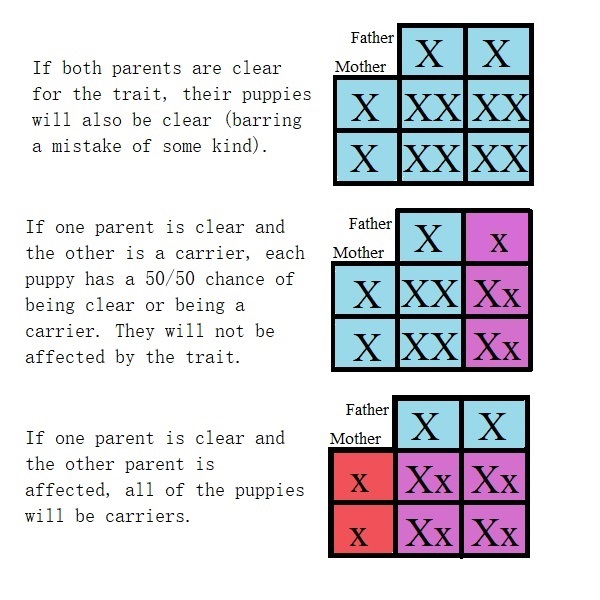

These examples hold true for any trait that is a simple recessive.
Note: statistics only hold true with very large samples, except for breeding clear to clear or affected to affected where all puppies will be like their parents. However a carrier to carrier breeding could have all clear puppies or could have all affected puppies.
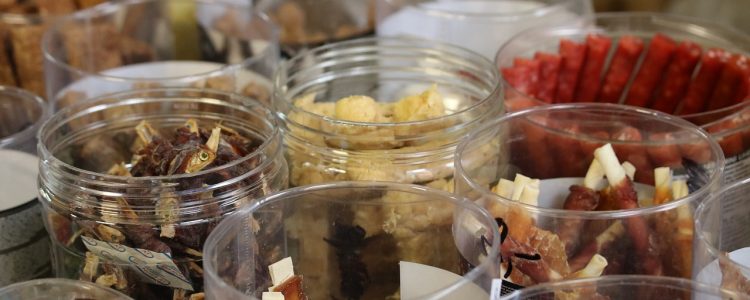
Whether you’re worried about the ingredients in commercial treats or you just want to do something special for your favorite four-legged companion, here are some simple recipes to make great tasting dog treats!
We’ll start with a favorite – yummy peanut butter treats!
Make them as-is or switch out the milk and peanut butter for a cup or 2 of pureed pumpkin. Or try switching rice flour for the wheat flour. Then see which one your dog likes best!
Yummy Peanut Butter Treats
INGREDIENTS
2 eggs
1/2 cup nonfat milk
1 cup creamy peanut butter
2 1/2 cups flour, whole wheat
1/2 Tbsp baking powder
1/2 tsp ground cinnamon
DIRECTIONS
Preheat oven to 350 degrees F.
Mix together the eggs, milk and peanut butter in a large bowl.
Gradually add flour, baking powder and cinnamon, using your hands as necessary, until the dough is stiff.
Sprinkle some flour on a work surface and roll out the dough to 1/4-inch thickness. Cut into 1/2-inch squares or dress it up with a bone-shaped cookie cutter. You don’t want your family to mistake them for people cookies!
Bake in preheated oven about 20 minutes. Turn over and bake for 15 minutes more.
Cool completely before storing in an airtight container.
If your dog suffers from allergies, here’s a recipe that he can enjoy without having to scratch. Instead of flour or oatmeal, it’s made with black beans.
Because of their soft texture, these cookies are also good for dogs that have trouble chewing the harder biscuits.
Anti-Itch Doggie Cookies
INGREDIENTS
1 cup cooked black beans, rinsed well and drained
1/4 cup creamy peanut butter
1/2 ripe banana, mashed
1/4 cup unsweetened applesauce
DIRECTIONS
Mash black beans using a fork or food processor. Add peanut butter, banana and applesauce. Stir until smooth. Cover and refrigerate 1 hour.
Preheat oven to 325 degrees.
Drop by rounded teaspoon onto nonstick cookie sheet and bake for 15 minutes. Remove sheet and flatten using the back of a spoon.
Return to the over and bake for 10 minutes. Turn cookies over and continue baking 15 more minutes.
Cool completely then store in an airtight container or freeze.
For a slightly different flavor, try substituting lentils for the black beans.
If it’s too hot or you just don’t feel like firing up the oven, you’ll love these easy-to-make treats!
Coconut Blueberry Frosty Treats
INGREDIENTS
1/2 cup coconut oil in solid form
Frozen blueberries
DIRECTIONS
Put a blueberry into each heart in the silicone mold. Set aside.
In a small saucepan, heat coconut oil until it liquefies.
Allow coconut oil to cool for a few minutes, then carefully pour oil into the heart mold.
Carefully place mold into the fridge to solidify.
When coconut oil treats are solid, pop them out of the mold.
Store coconut oil treats in a baggie in the freezer.
You can get a silicone mold to make heart-shaped treats here. Or pull out those old plastic ice cube trays, just don’t try to use a metal one because it needs to flex to remove the treats.
Here’s a simple grain-free recipe your dog will love!
Banana Almond Bites
INGREDIENTS
1 large egg
1/2 cup almond butter
1 banana, over ripe
1 tsp cinnamon
DIRECTIONS
Preheat oven to 350° F.
Using a fork, mash the banana in a large size bowl.
Add the remaining ingredients and mix together with a fork until blended. The batter should be thick and gooey.
Line a cookie sheet with parchment paper and place teaspoon-size dollops well-separated on the sheet.
Bake for 5 minutes, then turn the pan and bake for another 5 minutes.
Remove from the oven and cool. Be sure to refrigerate!
Here are some other ideas for treats:
- Baby carrots
- Sweet potatoes, sliced
- Apples, sliced
- Strawberries
- Watermelon, seedless
- Banana, peeled
- Eggs
- Sardines
- Cottage cheese
- Unflavored yogurt
- Chicken liver
- Chicken gizzards
- Broccoli, sliced
- Cauliflower, sliced
You might be surprised at what your dog likes. Most of my dogs love broccoli and cauliflower, but don’t like bananas! Go figure!
If you don’t have time to make your own treats, check out this post for quality store-bought dog treats.
This blog post contains affiliate links.
Header image courtesy Pixabay
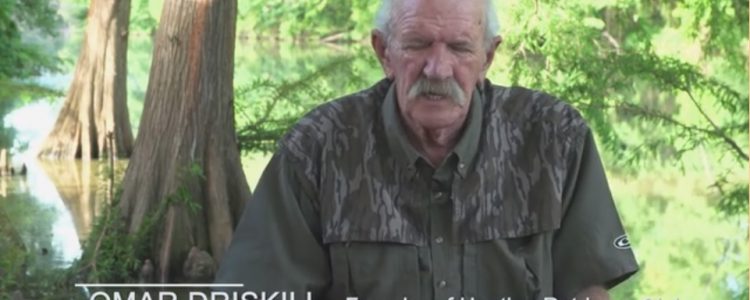
People have relied on their dogs for help retrieving game for many years. Probably many, many, many years.
As often happens when people get together, they’re compelled to see which dog is better. Thus the birth of competitive field trials.
But not everyone has the time, money, or desire to compete in field trials. However they sure do like to show off what their huntin’ dawgs can do! And so began the Hunting Retriever Club.
The birth of the Hunting Retriever Club
“Conceived by Hunters for Hunters” became the motto of the HRC. Judges strive to set up realistic hunting scenarios with duck calls and camo, real birds and handlers shooting shotguns (albeit with blanks).
Omar Driskill, Richard Walters and Bill Tarrant are some of the men instrumental in the founding of retriever hunting tests and the HRC.
I was lucky to be able to run my first HRC test under Omar and still have the ribbon he awarded my dog!
Watch the video to learn some history of retriever sports in general and the beginning of the Hunting Retriever Club in particular. I especially like the comment someone made about misnaming the Started stake. See if you can catch what he thought Started should have been called!
(Header image and video courtesy of the Hunting Retriever Club Inc.)

You think your dog works hard? Check out these dogs who rack up over 3,000 miles conditioning in just 6 months and then run 150 miles a day for over a week in competition.
Mitch Seavey, has won the Iditarod THREE times (2004, 2013 and 2017) and holds the record as the oldest person to win.
His son, Dallas, has won the Iditarod FOUR times (only one person has ever won it 5 times) in 2012, 2014, 2015, 2016.
Dallas holds the record for the youngest person to win. Mitch also came in second to Dallas in 2015 and 2016 and 3rd in 2014 when Dallas won and Dallas came in second to Mitch in 2017.
They’ve also smashed the winning time record over and over. Mitch currently holds the record at 8 days 3 hours 40 minutes 13 seconds. They are the first father and son duo in Iditarod history to claim the top two finishing positions of the race. Between them they’ve won the last 6 Iditarod races.
So why would I – a Lab person – tell you about sled dogs? Well, if a top musher chooses Dynamite products for his dogs it might be something for you to consider.
“We use Dynamite products year round in the kennel to maintain healthy, thriving dogs. The nutritional vitamin and mineral supplements are a key element in our their successful performance and great overall health,” says Dallas Seavey.
What other products does he use?
He says he’s had great success treating viral and bacterial infections “with activated Miracle Clay, Solace, Dyna Pro, and Trace Minerals Concentrate every 3 hours around the clock until well.”
Let me know if you have any questions about any of these Dynamite products!
Image courtesy Dynamite Specialty Products
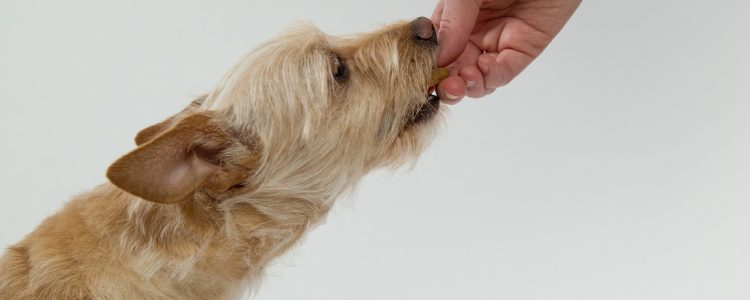
Who doesn’t love to give treats to their dog? But with so many commercial treats, it can be hard to make a good choice. Start off by looking for quality ingredients.
Signs of better quality:
- Natural preservatives (such as Vitamin C or E) or no preservatives at all
- Made in the USA
- Fresh, whole ingredients (human-grade, if possible)
Ingredients to avoid:
- Corn and wheat
- “Meal” and “by-products”
- BHA (Butylated Hydroxyanisole)
- BHT (Butylated Hydroxytoluene)
- Ethoxyquin
- Food Dyes (Blue 2, Red 40, Yellow 5 and 6, 4-MIE)
- PG (Propylene Glycol)
- Rendered fat
Consider where the treats are made
There have been on-going problems with pet food and ingredients coming from China. In 2007, there was a massive recall of Chinese-made pet food. Several thousand dogs became sick or died from food containing melamine – a type of plastic. The ingredient was traced back to a Chinese firm that was adding melamine to their food products to increase the protein percentage for bigger profits.
In 2014 there was another health issue that traced to Chinese pet treats. This time it involved imported jerky treats that were linked to over 1000 dog deaths.
Because of these problems, you should avoid pet food products imported from China. Unfortunately labeling laws don’t cover ingredients that come from China. Some manufacturers have imported base ingredients because of the lower cost and mixed them with other ingredients to make pet food in the US. These products can be labeled as ‘Made in USA’ without mentioning the Chinese ingredients.
Check the manufacturer’s reputation
You can search online for recalls, not just for the particular treat you’re considering, but for the entire product line. A manufacturer with several recalls may indicate an overall problem with quality control.
Check the calorie count
Just like people, there are many overweight dogs. Obesity causes all sorts of health issues, from heart disease and high blood pressure, to diabetes and joint damage.
Regardless of which treats you choose, be sure to subtract the calories in the treats from your dog’s daily calorie allowance. Many treats have lots of calories and feeding just a few every day will lead to weight gain.
If you’re not a calorie counter, do the touch test every couple of weeks. Lay the palms of your hands on your dog’s rib cage. If his ribs are sticking out, he’s too thin. If you have to press in to feel the ribs, he’s too fat.
What tastes best to your dog
For that you may have to try a few different treats, but I don’t think he’ll mind this kind of testing!
Here are some treats that score high in our consideration:
Newman’s Own Organics Premium Dog Treats
Heart-shaped, crunchy organic dog treats that come in a wide variety of flavors, including Chicken, Peanut Butter, Salmon and Sweet Potato, Turkey and Sweet Potato, and Cheese. They also come in small (1″) and medium (1.5″) sizes.
- No artificial flavors, colors or preservatives
- No wheat, soy or corn
- Made in Canada
- And the company gives 100% of profits to charity. Over $500 million so far!
“The dog loves them. They are scored to be easy to break in half for smaller dogs or for training nibbles. On ‘subscribe and save,’ the price is very good.” ~ LaRaine
Riley’s Organic Dog Treats
Bone-shaped treats that come in small and large size with a crunchy texture. They also come in a variety of flavors, including peanut butter and molasses, apple bone, sweet potato, and pumpkin and coconut bone.
- 100% human-grade, non GMO
- No wheat, corn or soy
- No artificial colors or preservatives
- USDA certified organic
- Made in the USA
“Fantastic product! Wish it was this easy to find healthy snacks for us human-kinds! My dogs, big and small, absolutely love these! Even my friend’s uber picky eater dog goes crazy for these treats!” ~ Kelrick
Nature Gnaws All Natural Dog Chews Bully Sticks
Made from 100% natural, grass-fed, free-range beef. Oven baked without added hormones, preservatives or chemicals.
- All natural, single ingredient
- No added hormones, preservatives or color
- Naturally high in protein and grain-free
- Good for chewing exercise
“My dog loves these and I’m happy to be giving her something that’s grassfed and natural. She’s a fairly vigorous chewer and can finish one in a single sitting, but I can also take it away halfway through and give back later. It keeps her occupied.” ~ Heidi
Wet Noses Organic Dog Treats
USDA certified organic and non-GMO treats that come in several flavors – hemp seed and banana, carob and mint, cranberry and flaxseed, apple pie, sweet potato pie, agave and pear, apples and carrots, grain-free berry, grain-free peas and carrots, peanut butter, and pumpkin.
- No corn, wheat or soy
- No artificial color, artificial flavors or preservatives,
- Made in USA, but only ships to the lower 48 states
“My little dog has an extremely sensitive stomach. I have to get his food from the vet. He can’t have beef, chicken, duck, lamb and grains. That leaves a lot out. My girlfriend has these treats and her dogs didn’t like them so she asked if my dog would like them. He goes nuts for these and they don’t seem to bother his stomach.” ~ Jeep Girl
Emmy’s Best Premium Chicken Jerky Treats
Thin strips of dehydrated, naturally preserved USDA Grade A chicken breasts. Thin and crispy. Sourced and produced in the US, in small batches.
- No fillers, additives or preservatives
- 100% satisfaction guarantee
- One-ingredient product
- Made in the USA
“My dog LOVES these. I have tried so many treats and she wouldn’t eat them. She would just push them around and over and over. Really she did. Until she received these Premium chicken Jerky Dog Treats. I believe this is my 4th order. They smell just like ‘baked’ chicken. You can break them into pieces easily.” ~ TamG
BLUE Wilderness Grain Free Crunchy Dog Treats
A dry, crunchy treat that’s available in a flavors like duck, salmon, turkey, potatoes and flaxseed. They also have some location-specific treats like Denali Biscuits with salmon, venison and halibut or Bayou Biscuits with alligator and catfish!
- 100% grain-free
- No corn, wheat or soy
- No artificial flavors or preservatives
“I love that I can give him a treat, and not worry about him braking out in a massive rash! He loves them, and we love these for him! Also since switching to this brand completely he has had so much more energy, is very playful again,and his coat has been simply amazing, and shiny.” ~ Becky85
Stella & Chewy’s Carnivore Crunch
Freeze-dried raw nuggets that are 98% meat, organs and ground bone from grass-fed, cage-free or wild-caught animals, including beef, chicken, duck or turkey. Minimally processed.
- No added hormones, antibiotics or fillers
- No artifical preservatives or colors
- Single source animal protein
- Grain-free
- Made in the USA, although the meat may be sourced from other countries, except China.
“…these treats/foods really do illicit an almost panicked, I’ll do ANYTHING, gotta have it, response!” ~ NewShoes!
Avoid these popular, but unhealthy treats:
Greenies Dog Chews
Although recommended by veterinarians, these treats are not all-natural and there have been problems with white worm infestation, vomiting and intestinal obstructions. The main ingredient is wheat gluten.
Rawhide dog treats
Although dogs seem to love chewing on rawhide treats they are not digestible. It can swell up in the stomach or intestine which can lead to diarrhea, vomiting and pancreatitis. If a piece gets stuck somewhere in a dog’s digestive tract, he will likely need surgery.
Milk Bones
Probably the most popular dog treat available, however the ingredients are very questionable:
- Wheat Flour
- Wheat Bran
- Wheat Germ
- Meat and Bone Meal
- Salt
- Beef Fat (Preserved with BHA)
- Sodium Metabisulfite (Used as a Preservative)
Even if you can get past the grain-heavy ingredients, the National Toxicology Program has concluded that BHA “is reasonably anticipated to be a human carcinogen.” Why feed something that may cause cancer?
Beggin Strips
Another product with very questionable ingredients:
- lots of grain (barley, oat meal, brewers rice, soybean meal, ground whole wheat, corn gluten meal, wheat flour, wheat gluten, ground yellow corn)
- glycerin and sugar
- soy protein concentrate
- salt, phosphoric acid, sorbic acid (a preservative)
- BHA – likely carcinogenic
- dyes (Red 40, Yellow 5, Blue 1, Yellow 6) – linked to cancer, allergies, hyperactivity, irritability and aggressiveness
Check for product recalls.
I hope you found some treats your dog really likes! If you’d like try making some of your own treats, check out this post with recipes.
Affiliate Links: This blog contains affiliate links.
I used to be a vet tech and blithely gave vaccines to all my animals. DHLPP for dogs, seven-way for horses, FeLP for cats. The veterinarians said they would keep my animals healthy and I believed.
Then I heard about the feline leukemia vaccine causing cancer in cats. I thought it would be better not to give this vaccine, but the Association of Feline Practitioners said to give it anyway – just give it in the cat’s rear leg.
Why, you ask? They say when the cat developed cancer they could just amputate that leg.
The more I thought about it, the more I distrusted the use of vaccines. Inject a small dose of the disease directly into an animal and hope their immune system could deal with it? How unnatural.
Then to increase the efficiency, the drug makers started adding adjuvants. These are substances that the World Health Organization listed as Class III carcinogens with Class IV being the highest risk. (IARC Monographs on the Evaluation of Carcinogenic Risks to Humans: Volume 74, World Health Organization, International Agency for Research on Cancer, Feb. 23-Mar. 2, 1999, p. 24, 305, 310.)
Although required by law, the rabies vaccine is one of the most dangerous of the vaccines. Researchers believe it causes the most and worst adverse reactions in animals, including cancerous tumors at the injection site. Here is a webpage I came across recently that chronicles the decline and eventual death of an Australian Shepherd after her second rabies vaccination. (Note: Although this website is no longer functional, it can be seen on the Wayback Machine. Enter this URL in the search field – http://www.pinecrest-aussies.com/in-memory-of-belle.html)
There is a study underway to improve the safety of rabies vaccines and to determine, by challenge, if they confer immunity for longer than three years as currently believed by most states. One French study showed dogs were immune to a rabies challenge five years after vaccination, while a study in Wisconsin found sufficient antibody titers after seven years.
UPDATE – January 25, 2018
Research shows that dogs who have received two doses of rabies virus vaccine are protected for at least FIVE years. The study is still ongoing and they are collecting and analyzing data from 6.5 and 7 years post-vaccination.
Here are links to more information about vaccine dangers:
Veterinarian Quotes
http://www.yourpurebredpuppy.com/health/common/vaccinations.html
Ron Schultz, DVM quoted on Shirley’s Wellness Cafe
http://www.shirleys-wellness-cafe.com/petvacc.htm
Vaccine Safety
http://www.vaccines.net/newpage114.htm
Header image courtesy Pixabay
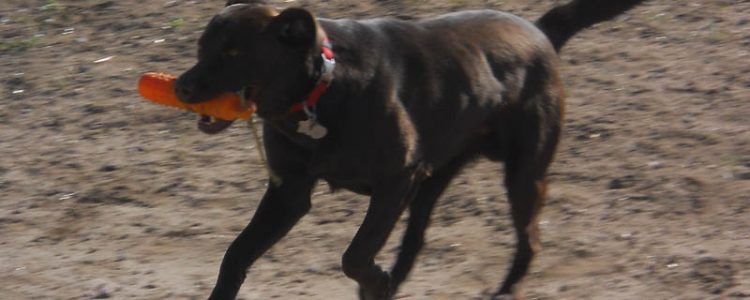
I’m trying to work with Breaker a little each day though it’s tough to do all this with just the knowledge I’ve gotten from Joe, Brian and yourself. I’m trying as best I can! I hope to see you again soon!!
Sarah
Hi Sarah –
For Breaker, just keep working on the basics. Work on obedience – heel, sit, come and down. You can do this at home.
Throw marks in different areas and different lengths (watch out for snakes). If he has any trouble with longer marks, see if you can get someone to help by throwing.
Pick out a nice place with fairly short cover and at least 100-150 yards of open area. Have your thrower stay at the same place while you move back with each throw. Start at a distance a little shorter than his best comfort zone – maybe 30 yards – have him sit while the thrower tosses the bumper.
As Breaker picks it up, you back up about 5-10 yards while encouraging him to come to you. Throw the same mark again and run him from this longer position. If he’s doing well, back up another 5-10 yards as he’s coming to you.
Do 3-4 of these at every opportunity and gradually increase the distance. When he’s comfortable out to 150 yards or so on short cover, go back to the shorter distance (30 yards +/-) but this time in higher cover and start increasing the distance again. Probably best to increase by a shorter amount each time because finding bumpers in cover is much more challenging.
Also work on his steadiness. Hold his collar, but require him to sit still and quiet until you release him.
When he’s doing really well and you think he won’t break, slip a short (~ 2′) length of cord like clothesline through his collar and hold both ends with slack in it so he doesn’t feel you holding him. If he breaks, stop him with the cord and have the thrower pick up the bumper. Try again. Only release him for the retrieve if he stays steady. Also vary the amount of time he has to sit after the bumper lands (1 or 2 seconds up to 6 or 7 seconds on occasion).
Also vary the type of ground and cover you work him on. For example, use a ballfield for increasing distance with short cover. Then try to find some place with plenty of cover.
Look for a small ditch – but make sure it’s very visible to him. Look for a creek or pond. Look for a hillside and throw marks up, down and across (not in the same session tho).
Try throwing downwind and crosswind marks (not into the wind because he will smell the bumper early and could start quartering). Basically give him experience picking up bumpers and birds in as many situations as you can find.
When he’s doing well and has all his teeth in – he should by now – you can start on force fetch. Some dogs will need to stop picking up marks until force fetch is completed just because they get pissy over HAVING to pick up something. Other dogs don’t care.
Just make sure once you start force fetch you see it through to the end, otherwise the dogs wind up learning they don’t have to fetch and won’t fetch unless they feel like it. Tough to correct!
Hope to see you soon!


